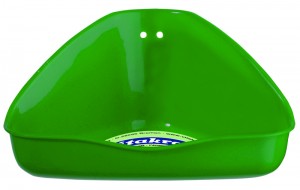Yes, you usually can. Nowadays you can buy a special litter tray that will fit in the corner of the cage – but remember to get a large one so that it is big enough for when your hamster grows bigger. Or use a shallow tray like the ones put underneath plant pots or the shallowest kind of the rectangular plastic trays on which supermarkets sell vegetables. Some hamsters will even use an extra large jam jar on its side (Adby & Neill 2004). Don’t use cat litter for hamsters: buy special hamster litter.

Vitakraft tray – open thus OK for fatty hamster. Buy at www.widmer.co.uk
Give your hamster time to settle in without the litter tray to begin with. Most hamsters use just one area to urinate.Wait till he has chosen his latrine area, and then put a litter tray in the place he has chosen (Logsdail et al., 2002). It is important to put the litter tray where the hamster wants it, not where you want it.
To encourage use, put some soiled material from the urination site at the bottom of the cage, into the tray so that the tray smells of urine. Some hamsters use the little houses as latrines, perhaps because they feel more secure in a covered area. In which case, try putting the tray under the little house. Most hamster (though not all) will adapt to this. When cleaning the tray either just use boiling water, or if you use disinfectant rinse it thoroughly. Keep back a little of the soiled litter from the tray to put into the cleaned tray. Scent is important to hamster so it must smell of pee not disinfectant.
REFERENCES
Adby, S., & Neill, D. O, (2004), Hamsters in Sickness and in Health, Milverton, UK, Capall Bann Publishing.
Logsdail, C., Logsdail, P. & Hovers, K., Hamster Lopaedia, A Complete Guide to Hamster Care, Dorking. UK, Ringpress.